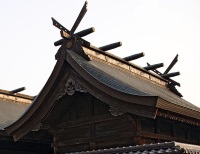Chigi Cross
a Shinto cross
Artefacts from around two thousand years ago show the Chigi being used as a bargeboard; part of a frame to secure roof thatch.
As building techniques and roofing materials evolved the Chigi was retained, becoming both ornamental and symbolic. Today they are seen atop Shinto shrines all over Japan.
Usually the cross arms are straight, often decorated with carvings and wind slots to withstand Japan's severe typhoons.
An interesting feature to note is the angle at the top of the Chigi arms. When cut horizontally, facing the sun, they honour the Sun Goddess or mark the enshrinement of a female kami. A vertical cut implies enshrinement of a male kami.
Although the Chigi cross was most likely introduced in roof architecture around the 1st century AD, when St. Andrew was crucified on the same shaped cross, it's doubtful the Christian use of the symbol had any influence on its adoption by Shintoism. Christianity didn't reach Japan until the 16th century, long after the Chigi had been established in kami worship.
And unlike the association between the St. Andrew's cross and crucifixion, there is no record of Japan using the Chigi as an instrument of torture; rather a vertical post with a horizontal arm was employed, in the same manner as most other cultures.


